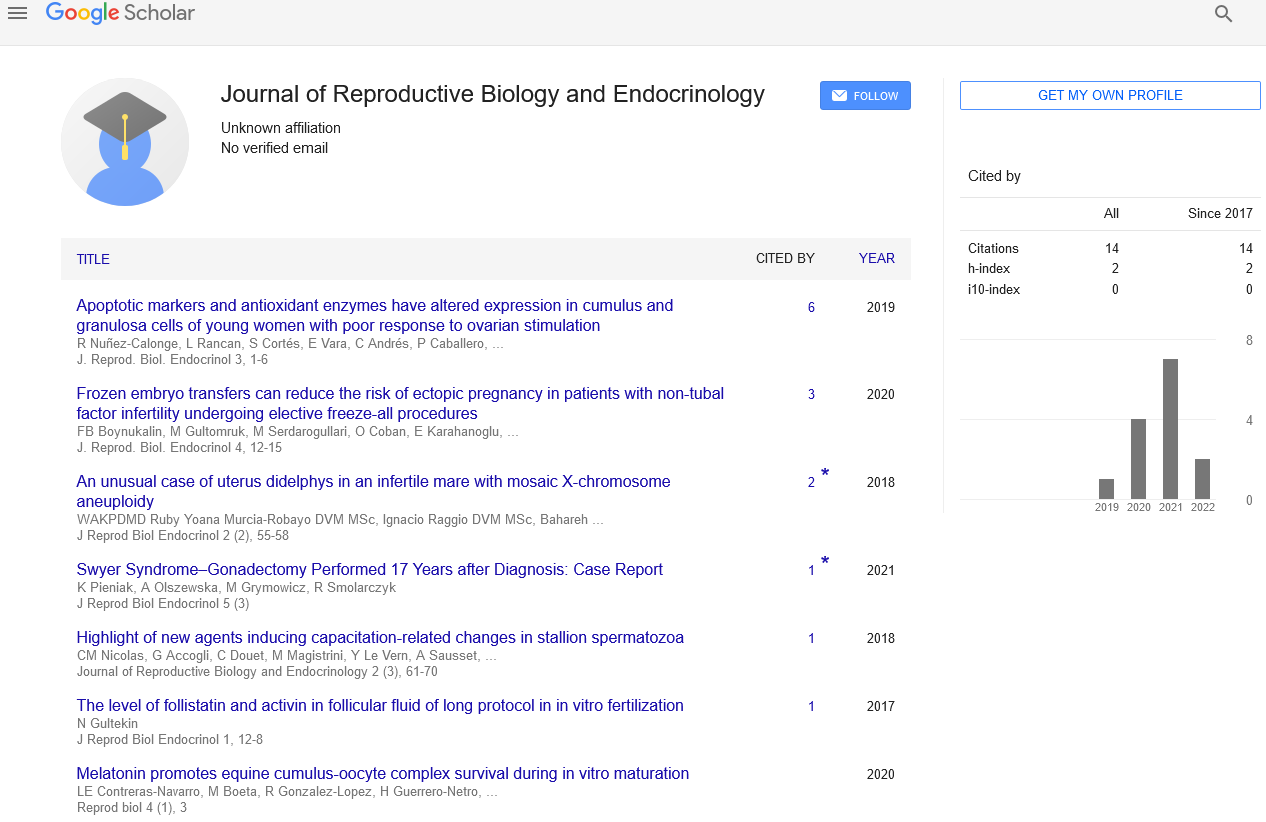Uterine abnormalities that are congenital and impact reproduction
Received: 19-Dec-2022, Manuscript No. PULJRBE-22-5930; Editor assigned: 21-Dec-2022, Pre QC No. PULJRBE-22-5930 (PQ); Accepted Date: Jun 27, 2023; Reviewed: 04-Jan-2023 QC No. PULJRBE-22-5930 (Q); Revised: 22-Mar-2023, Manuscript No. PULJRBE-22-5930 (R); Published: 30-Jun-2023, DOI: 10.37532/PULJRBE.2023.7(2).3
Citation: de Souza A. Uterine abnormalities that are congenital and impact reproduction. J Reprod Biol Endocrinol 2023;7(2):3
This open-access article is distributed under the terms of the Creative Commons Attribution Non-Commercial License (CC BY-NC) (http://creativecommons.org/licenses/by-nc/4.0/), which permits reuse, distribution and reproduction of the article, provided that the original work is properly cited and the reuse is restricted to noncommercial purposes. For commercial reuse, contact reprints@pulsus.com
Abstract
Over the course of 18 years, 182 women with uterine abnormalities in total were observed. Overall, 126 women had 265 pregnancies, with a foetal survival rate of 66%, perinatal death of 8%, and 23% of preterm births. Complete estate uteri had the highest foetal survival rate (86%) compared to complete bicornuate uteri (50%) and unicornuate uteri (40%) when the uterine anomalies were categorised according to the degree of failure of normal uterine development. The partial bicornuate uteri (17%), whose foetal survival in operated cases was 53% before operation and 100% after, saw the largest use of cervical circulate. With the exception of complete estate uteri (25%) and complete bicornuate (0%), all groups had a 40%– 50% breech presentation frequency. Patient deliveries had the highest rate of caesarean sections (82%). All 3850 infertile patients had high-quality 3D photos taken of them, and in 23.2% of them, 3D US indicated uterine anomalies that could be surgically corrected. 17.9% of the population who were infertile as a whole had uterine septa. The most frequent uterine anomaly, accounting for 77.1% of the intracavitary lesions, was uterine septum. 225 (72.6%) of the 310 patients that were followed up on became pregnant. After septal incision, 57.7% of patients experienced term deliveries, whereas 15.4% experienced preterm births. After the septum was removed hysteroscopically, the percentage of spontaneous abortions fell from 41.7% to 11.9%. In patients with infertility, three dimensional ultrasound can be used as a screening approach to find uterine anomalies. After surgical hysteroscopy, we discovered a considerable improvement in the reproductive outcome
Keywords
Hysteroscopically; Intracavitary lesions; surgical hysteroscopy; Unicornuate uteri; Septal incision
Introduction
The endometrial cavity is commonly examined with transvaginal ultrasonography. Women with significant monthly blood loss and infertility issues frequently undergo 2-DHS, a B-mode transvaginal ultrasound technique that involves injecting sterile saline solution into the endometrial cavity. However, 2-DHS does not allow for a thorough evaluation of the uterine cavity and any potential abnormalities.
Early on, a sex neutral developmental phenotype permits the emergence of both the mesonephric (wolffian) and paramesonephric (muellerian) ducts between weeks 5 and 8 of gestation. The uterus, fallopian tubes, cervix, and upper vagina are all produced by the mullerian ducts when the sertoli cells of the growing testis do not produce Mullerian Inhibiting Substance (MIS). The wolffian ducts regress during this stage, however it is hypothesised that they serve as a guide for the mullerian ducts downward expansion. The mullerian duct goes through a process of elongation, fusion, canalisation, and septal resorption between weeks 8 and 18, which will eventually result in the development of the aforementioned female reproductive components. The caudal section of the Mullerian ducts fuses after about 12 weeks.
Description
It is uncertain how often uterine abnormalities actually are in the general population. Because of the uneven diagnostic methods used in the past and the diversity of the subject populations that were investigated, it is insufficient to consult earlier medical literature. Increased discovery of uterine anomalies in the general population can be anticipated with the widespread use of transvaginal ultrasonography and Hystero Salpin Gogram (HSG) in reproductive age women, particularly in the infertile and recurrent miscarriage subgroups.
The availability of Magnetic Resonance Imaging (MRI) and three Dimensional Ultrasound (3D US), following the discovery of uterine abnormalities by ultrasound and HSG, could boost the accuracy of this diagnosis when diagnostic criteria are implemented more consistently.
Conclusion
Although it was first believed that the didelphic uterus had no effect on reproductive outcomes, a new analysis of the literature reveals that it does raise the incidence of premature births and miscarriages.
Similar to the unicornuate uterus, the didelphic uterus is more likely to mispresent and require caesarean delivery due to dystocia. The worst outcomes occur in patients with unicornuate uteri, who have greater rates of miscarriage, ectopic pregnancy, premature delivery, and lower live birth rates.
The chances of getting pregnant for people who have vaginal agenesis seem to be similar when using IVF, oocyte retrieval from the affected patient, and embryo transfer into a gestational carrier. Because of the wide range of related genital anomalies not only uterine DES exposed patients had higher chances of miscarriage, ectopic pregnancies, and preterm delivery.





